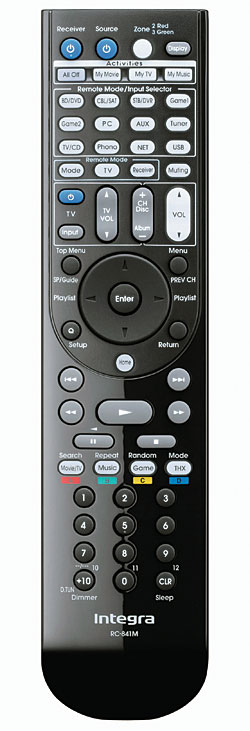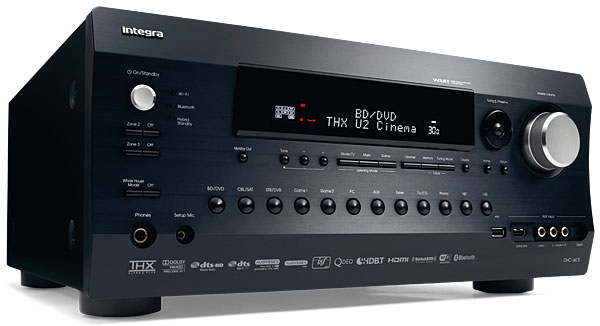I HATE (with a PASSION) this trend! "Let's make a box with a ton of features, but sounds like crap!" ENOUGH! If you are spending $2000 on a pre-amp/processor, shouldn't it SOUND GOOD? Onkyo/Integra has been sliding down the slippery slope the past few years...tacking on features, and paying next to NO attention on their sound quality. I would recommend taking a pass on this one...HDBaseT and 4k upscaling is nice, but if you are buying separates, you should at least get something that sounds better than the competition's AVRs!
Integra DHC-60.5 Network A/V Controller Page 2
B oth the front and rear panels are cleanly laid out, and the learning remote control is ergonomically designed, fully configurable, and easy to use, though it is not globally backlit. Instead, a few important buttons at the top light up after you push them. (Integra also has a control app that can be downloaded for iOS or Android devices.) Minor caveats aside, the DHC-60.5’s complete setup was relatively easy overall,
and its day-to-day use was uneventful and confusion-free.
oth the front and rear panels are cleanly laid out, and the learning remote control is ergonomically designed, fully configurable, and easy to use, though it is not globally backlit. Instead, a few important buttons at the top light up after you push them. (Integra also has a control app that can be downloaded for iOS or Android devices.) Minor caveats aside, the DHC-60.5’s complete setup was relatively easy overall,
and its day-to-day use was uneventful and confusion-free.
Integra Sonics
Despite the inclusion of 192-kHz/24-bit Burr-Brown DACs, including noise-cancelling dual-differential pairs for the front L/R channels, I wasn’t too happy with the DHC-60.5’s sonics after swapping it in for my reference Marantz AV7005 pre/pro. The sound was more or less serviceable for movie watching while driving the superb Parasound Halo A 51 amplifier (5 x 200 watts) in balanced mode, which in turn drove my Sonics By Joachim Gerhard Amerigo speakers (since renamed Canalis, original review available at soundandvision.com). But I found it far less engaging for music.
I’ve been watching and enjoying the unintentionally campy summer replacement series Under the Dome. The writing is sometimes hilariously flat and clichéd, as when the corrupt and now dead local preacher spouts in a tough situation, “Bless you, my child,” or a recently arrived sado-masochistic babe exclaims, “You will do as I say!” Who talks like that? After a few episodes, you get a good handle on the recordist’s and sound mixers’ work. The series is pretty good sonically, but in my first week watching with the DHC-60.5, I noticed I was experiencing greater difficulty understanding the dialogue, which sounded slightly muffled compared with what I was used to.
After hearing similar results during a news broadcast that came on after, I re-checked all the settings and listened to more TV news in Direct mode, thus bypassing Audyssey, tone controls, and anything else that might be getting in the way of sonic purity. The vocals remained simultaneously softly obscured and slightly metallic.
Switching to familiar CDs in Direct mode with no subwoofer (my speakers can easily go to 30 hertz), I found the DHC-60.5 produced spatially flat, dynamically anemic-sounding music on a small, uninvolving soundstage. As an example, Metallica’s “Enter Sandman” produced indistinct cymbals, thin-sounding drums, and a kick drum whose bass component seemed unconnected to the low frequencies produced by the kick.
From earlier listening experience, I know that Phoebe Snow’s “Poetry Man,” as heard on a CD made from a spectacular-sounding double 45-rpm reissue, should sound vividly three-dimensional with appropriately sharp percussive transients on the bell tree and shaker. A harp glissando should soar. The stand-up bass should have a woody texture and supple pluck. But it all sounded flat, soft, and rubbery on the DHC-60.5.

I tried a superbly recorded 2L Blu-ray Disc of Schubert’s String Quartet No. 14 in D minor, “Death and the Maiden” (EAN 13), listening to both the 192-kHz/24-bit two-channel PCM track in Direct mode and the 5.1-channel DTS-HD 192-kHz/24-bit surround mix. I found the string tone unpleasantly hard in the upper mids, yet soft and amorphous in the lower registers. The surround mix added some space, but the string tone remained the same. No wonder dialogue intelligibility was poor.
Yes, this is a midline pre/pro, but my reference $1,600 Marantz AV7005 driving the same amplifier and speakers playing the same discs simply sounds considerably more dynamic, with more punch on bottom and greater clarity, transparency, and definition on top. The Marantz produced vivid harmonic colors, clean transients, greater dimensionality from two-channel sources, a bigger soundstage, and all of the elements that produce listening pleasure as opposed to either listening fatigue or disengagement.
Of course I watched movies too, including the silly farce Horrible Bosses, the touching Robot & Frank, and for the full surround sound extravaganza experience, Skyfall. Dialogue intelligibility was mediocre on all but on Skyfall, where the DHC-60.5 also produced a reasonably engaging surround sound bubble.
Given Integra’s excellent track record delivering good-sounding, high-value pre/pros (several of which have been used by our reviewers over the years as their reference), editor Rob Sabin asked me to listen to a second sample of the DHC-60.5 to ensure there were no issues with our original test unit. This second unit supplied by Integra sounded identical to the first. As we approached our print deadline, Sound & Vision senior editor Tom Norton also informally put our original sample through its paces in his own system, where he found it just a bit brighter sounding than his current Integra DTC-9.8 reference while using his own Parasound Halo A 51 amplifier driving the new Revel Performa speakers. He further compared the DHC-60.5 to the front-end pre/pro section of the new Marantz SR7008 receiver and found both Integras to be distinctly brighter in character, though he was not able to spend enough time to fully compare the more subtle aspects of the DHC-60.5’s sound that I heard in my extended auditions.
Conclusion
Though it is packed with features that all worked well, a generous supply of HDMI and digital inputs, and just about every conceivable bell and whistle—not to mention being one of the first pre/pros to include ground-breaking HDBaseT technology—I found the Integra DHC-60.5’s sonic performance disappointing. I suppose it’s possible that others might get different results mating it with other components, or that less critical
or experienced listeners would overlook or not hear its flaws. But, when plugged into my reference system in my home, it drove a superbly designed $4,500 amp-
lifier and managed to make it
sound mediocre.
- Log in or register to post comments


Reviews should be used as a guide not as Gospel. I'm not sure what was wrong with his system, but this reviewer got it very wrong. I have been in the high-end audio video business since the 70's, including owning a well respected retail business as well as hosting a radio talk show on the subject. I have also been a studio engineer since the 80's actually creating and mixing audio. I tested both the 60.5 pre-pro and the receiver. The sound is so good from both that I purchased the receiver for my own 11.2 system and have recommended the units for others. It never ceases to amaze me that folks comment on reviews so passionately without ever hearing the stuff for themselves. Shame on you if you have done so.

I moved away from Integra after numerous unsuccessful tweaks and procedures with the DHC-80.2 to achieve a more gentle sound. I was continually either fatigued with the Audyssey XT32 correction or frustrated by a drab and confused sound with direct modes. Like others, I felt like I was wasting a great amp (NAD T955) with the Integra. As popular it is in the lucrative custom installer market, I think Onkyo has lost touch with the end benefit of pleasurable listening and focused on endless specs and features.
I'm currently enjoying Pioneer Elite but very tempted to try Marantz.

This review is why I have remained a fan over all these years. Occasionally your magazine (now including the Sound and Vison staff)reviews a product that does not get glowing and raving reviews; this just proves that you are doing your jobs by providing consumers unbiased and professional journalism. Thank you.

My Integra 80.2 and the newer 80.3 are excellent. So when I saw the review in Sound & Vision I expected the sound would be terrific with lots of new wireless connectivity options.
Instead what we find is they shortcut the audio design. Why? What were they thinking. At least the Editor asked the reviewer to check a second sample to confirm that the original unit was not defective. Then to give it to the best tech guy they have and he concurred.
Bad job Integra. Your reputation is going down hill fast.
For a preamp, sound quality is first, connectivity is third and flexibility is second. Bad...bad...bad.

Re-read the article, the second guy did not concur. In fact he found the sound "brighter". And the reviewer said
"He further compared the DHC-60.5 to the front-end pre/pro section of the new Marantz SR7008 receiver and found both Integras to be distinctly brighter in character, though he was not able to spend enough time to fully compare the more subtle aspects of the DHC-60.5’s sound that I heard in my extended auditions."
That's code for "he did not hear what I heard"
I have tested both the receiver and pre-pro and they sound amazing. Vastly better than any Pioneer Elite or Marantz pieces I've tested. The 60.5's are delicate, dynamic, and make even mediocre speakers sound good. You with your "bad bad bad" comment without ever hearing the units are just describing yourself.



































































